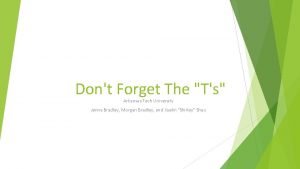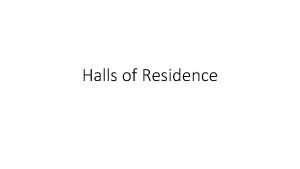The Dirty Truth Trash In Residence Halls Danielle

- Slides: 1

The Dirty Truth: Trash In Residence Halls Danielle Flanagan, Elliot Judware, Keara Smith, Jocelyn Vierzen Mentored by Jenn Andrews & Nicole Tichnor SUST 750: Sustainability Capstone Spring 2018 Introduction Results The abundance of waste produced in the United States has become a substantial problem for sustainable development. Universities possess the resources to contribute to research and make fundamental strides toward more sustainable practices on and off campuses [1]. Waste audits are a useful way to understand the composition of the waste and how much of the waste could have been recycled. The University of New Hampshire has made influential strides toward sustainability, earning a STARS Platinum rating, but has a waste score of 3. 6 out of 8, indicating a need for improvement [2]. Total Waste Composition Landfill Recyclable/Compostable 50% of total waste collected could have been diverted from the landfill 34% Recyclable 16% Compostable ○ ○ Discussion 45. 76 lbs 45. 70 lbs Research Questions What are residents of UNH dorms throwing away? How much of this waste could have been diverted from the landfill to be recycled or composted? Methods Results Figure 4. Shows the total amount of landfill vs. recyclable and compostable waste in the dumpsters from all three dorms. A waste audit entails removing garbage from waste sites to be categorized and sorted based on set criterion. These categories are later weighed and data is recorded to provide an understanding of waste composition. Three waste audits were conducted during the month of March at Christensen, Congreve and Fairchild dorms. 25% of waste in each dumpster was removed to be sorted into twelve categories based on landfill/recyclable/compostable/other. Our results show that there is either a lack of understanding or a lack of concern regarding proper waste disposal for students living in UNH residence halls. A waste audit conducted at the University of Wisconsin found that 39% of the waste could have been recycled. The similar results from our waste audit indicate that proper waste disposal is a systematic problem on college campuses. We also found that regardless of dorm style, kitchen capacity, or population demographics, the results were similar across the board. This illustrates a general need for education for all college students surrounding best waste management practices. This research provides a foundation for deeper analysis and future projects regarding waste on campus. Next Steps • Outreach programs for students may include more detailed signage, murals addressing sustainable waste practices, or community events. • The research is intended to be built upon for future projects conducted in conjunction with the Zero Waste Task Force and the Sustainability Institute at UNH. • There is opportunity for collaboration with Waste Management and UNH Facilities to routinely educate residents of the UNH community on the impacts of waste. Figure 1. Measuring landfill category of waste References Figure 2. The waste from one dumpster at Christensen pre-sort Figure 3. Recording the weight of each category Figure 5. Compares the trash composition of the three sampled residence halls. 1. Vega, C. A. , Benitez, S. , & Barreto, E. (2008). Solid Waste Characterization and Recycling Potential for a University Campus. Waste Management, V: 28 S 21 -S 26. 2. AASHE (2017). Stars Participants and Reports. Association for the Advancement of Sustainability in Higher Education. Retreived from https: //stars. aashe. org/institutions/participantsand-reports/? sort=rating

